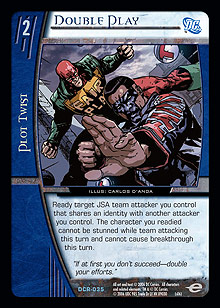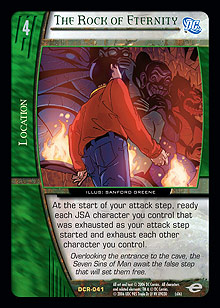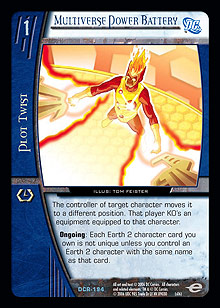
“The Value of Identity is that it so often comes with purpose.”
—Richard R. Grant
Welcome back for another exciting installment of Creating a Crisis. This week, I want to take a look at the JSA and talk a bit about how their mechanics developed. Back when I first started doing research for Infinite Crisis (i.e., reading lots of comic books), I wasn’t a huge fan of the JSA. I started reading some current JSA comics, and I have to be honest—I felt kind of lost. Many characters referred to (or worked with) previous incarnations of themselves and it was clear that a long history provided the backdrop for the story I was reading. Since I didn’t know any of the back-story, I had a lot of trouble enjoying the comic. I felt bad about designing a team that I didn’t really understand, so I tried a different approach and started reading old JSA graphic novels before jumping into the new stuff. Suddenly, things began to make sense. I finally started to get the connections and references, and more importantly, I began to appreciate the rich tapestry of history that is at the core of the Justice Society. The importance of legacy and passing on the mantle from one hero to another is a central theme of the team, and emphasizing the importance of identity seemed like the perfect way to represent that.
Identity Matters
Using identity allowed us to gain a ton of design space without adding anything new to the cards. It also helped to narrow down which characters to print by focusing primarily on those characters with the strongest attachment to previous identities. The JSA has a huge roster of characters affiliated with it and it would be impossible to print them all in one set. Even with the reduced focus in Infinite Crisis, the JSA still has the most characters of any team in the set.
 The biggest controversy over using the identity mechanic was what to do with all of the old characters that should have identities but don’t. In the past, we only used the ◊ identity when a hero had multiple incarnations that we wanted to print. Iconic characters like Batman and Superman didn’t have identities despite the fact that they were both clearly heroes with identities. In order to fix this problem, we introduced the rule that all characters without a printed identity have their name as their identity. This rule made the identity mechanic work much more intuitively and let Azrael ◊ Batman and Batman, Earth 2 arrange a Double Play. Of course, this also means that Luke Cage now has the identity “Luke Cage” and that Mordru can gain the identity of mighty “Unus,” but that was a small price to pay.
The biggest controversy over using the identity mechanic was what to do with all of the old characters that should have identities but don’t. In the past, we only used the ◊ identity when a hero had multiple incarnations that we wanted to print. Iconic characters like Batman and Superman didn’t have identities despite the fact that they were both clearly heroes with identities. In order to fix this problem, we introduced the rule that all characters without a printed identity have their name as their identity. This rule made the identity mechanic work much more intuitively and let Azrael ◊ Batman and Batman, Earth 2 arrange a Double Play. Of course, this also means that Luke Cage now has the identity “Luke Cage” and that Mordru can gain the identity of mighty “Unus,” but that was a small price to pay.
The identity theme also played a huge role in the development of the Fate Artifacts and what turned out to be a Fate sub-team that is having a huge impact on Constructed right now. Giving out the identity “Fate” allowed us to create an exciting and open-ended ready effect in Fate Has Spoken. Next week, I will take a closer look at the Fate engine, including an analysis of where we may have gone wrong.
Bonus While Exhausted
The second major theme of the JSA is the exhaustion theme. I knew that I wanted to explore this mechanic as soon as I saw Darkoth, Death Demon in Andrew Yip’s Fantastic Four Starter. I thought that this card was really cool and saw a lot of potential design space there. Gaining benefits while exhausted is naturally good while attacking, but a team built around controlling whether or not its characters were exhausted could make an otherwise mediocre effect into a fantastic one.
 As you may have figured out by now, I love breaking rules in Vs. System. Almost every time a cost is introduced in Infinite Crisis, I included at least one card to help “cheat” that cost. Vengeance characters have Join Us or Die, magic users have Shazam, and the Checkmate Kings have Threat Neutralized, to name a few. Arguably, the most powerful “cheat” in Infinite Crisis is The Rock of Eternity. Being exhausted while defending will often allow you to blunt enemy attacks with cards like Advance Warning, but what fun is keeping your defenders alive if you can’t attack with them? The Rock lets players have access to incredible power by effectively nullifying pre-attack exhaust costs. This power comes at a price, however. We intentionally limited the JSA’s ability to exhaust its own characters. Though there are many cards that can exhaust one or two characters, players must look to other teams for a strong poly-exhaust effect. This creates some tension and excitement when players use the Rock, since they risk exhausting their own attacker on a critical turn.
As you may have figured out by now, I love breaking rules in Vs. System. Almost every time a cost is introduced in Infinite Crisis, I included at least one card to help “cheat” that cost. Vengeance characters have Join Us or Die, magic users have Shazam, and the Checkmate Kings have Threat Neutralized, to name a few. Arguably, the most powerful “cheat” in Infinite Crisis is The Rock of Eternity. Being exhausted while defending will often allow you to blunt enemy attacks with cards like Advance Warning, but what fun is keeping your defenders alive if you can’t attack with them? The Rock lets players have access to incredible power by effectively nullifying pre-attack exhaust costs. This power comes at a price, however. We intentionally limited the JSA’s ability to exhaust its own characters. Though there are many cards that can exhaust one or two characters, players must look to other teams for a strong poly-exhaust effect. This creates some tension and excitement when players use the Rock, since they risk exhausting their own attacker on a critical turn.
To give you an idea of how powerful the Rock could have been, I’ll show you the version of the card in an early design file:
At the start of your attack step, ready each JSA character you control that was exhausted, and exhaust each other character you control. <p> Activate, exhaust a character you control >>> Replace a resource you control.
The extra activate ability gave players an out clause if the Rock wasn’t going to work for them. If you had one extra guy that needed to be exhausted, you could simply replace an unnecessary resource. If you couldn’t exhaust anybody that turn, you could exhaust your smallest character to get rid of the Rock itself! That in the end made the card too reliable and not nearly as exciting, not to mention the fact that continuously being able to replace resources you control is very powerful and should almost certainly be reserved for cards where that is their primary effect.
Attacking Up the Curve
This sub-theme was inspired by Mr. Terrific as a way to represent “fair play.” Both Mr. Terrifics and T-Spheres stayed pretty much the same throughout the design and development process. The theme was very cool and created interesting scenarios where the correct play to combat them was often to underdrop intentionally for the turn. R&D liked the theme so much that we expanded it onto Power Girl, Earth 2 and Kate Spencer ◊ Manhunter to allow an entire archetype to be built around it.
Earth 2
This was probably the most controversial theme of the JSA. Earth 2 is central to the Infinite Crisis storyline, and I wanted to make it feel special in the Vs. System. R&D had many discussions about how Earth 2 should work. Originally, I wanted to make Earth 2 a relevant character version similar to Army. The rules for Earth 2 would allow them to be non-unique with non–Earth 2 characters. There were several problems with this approach, however. First, if we ever wanted to do more than one Earth 2 character with the same name, we would need to come up with a new version that included the rules for Earth 2. Introducing the need for two-part versions seemed excessive, so we began to look at other ways to show that a character was from a different dimension (such as using the Mutant trait line, adding an Earth 2 icon to their names, and so forth). None of the potential solutions were all that appealing.
More important than the templating issue, however, was the question of whether or not creating a new rule was worth the trouble. Any time we introduce a new rule to Vs. System, it creates an increased burden on players. For longtime Vs. fans, this isn’t usually a big deal. Most sets introduce one new keyword and occasionally new rules. But when you expand the number of new rules or obscure rules and non-reminder-texted keywords, you make it much more difficult for new players to get into the game. R&D is very concerned about keeping the Vs. community vibrant and growing, and the only way we can do that is by constantly attracting new people to the game. Vs. is already a complicated game, so we need to be very careful whenever we add extra rules to remember.
 This left us with a dilemma. We wanted Earth 2 characters to be special and non-unique with regular characters in certain situations, but we didn’t want to create a new rule for this small subset of characters. The solution to this problem was two-fold. First, we created Multiverse Power Battery. This card allows players to “recreate” Earth 2 and fulfills a similar mechanical role that a special Earth 2 rule would have.
This left us with a dilemma. We wanted Earth 2 characters to be special and non-unique with regular characters in certain situations, but we didn’t want to create a new rule for this small subset of characters. The solution to this problem was two-fold. First, we created Multiverse Power Battery. This card allows players to “recreate” Earth 2 and fulfills a similar mechanical role that a special Earth 2 rule would have.
The second step to solving the Earth 2 problem was to find a way to make them feel special. Since we didn’t want to use a new rule or keyword to achieve this, I had to rely on creating a mechanical link between Earth 2 characters. This mechanical link had to be strong enough to evoke a sense of connection between all Earth 2 characters, but I didn’t want it to overshadow the team-themed mechanics on these characters. The simplest way to achieve that goal was to have each Earth 2 character reference other Earth 2 characters. This solution worked out really well and even created some cool interactions using Huntress, Earth 2 and Superman, Earth 2. We also made it possible to build an Earth 2–themed deck by making one Earth 2 character at each drop point from 1 to 8.*
Justice Society Forever
The JSA has a lot of themes for a standard Vs. team. Because of that, not every theme in Infinite Crisis could be explored as fully as I might have liked. That’s okay, though. A team as big as the Justice Society cannot be captured entirely in one set. When they return, whoever is designing that set will have plenty of space in which to play. Also, expect to see some of the JSA’s themes appear in other teams between now and when they are re-featured. By splitting certain themes between sets, we hope to create more natural synergies that encourage team-ups and increase the long-term relevance of previously underpowered teams. Checkmate is a good example of the second half of this process, giving a much needed boost to the classic League of Assassins location theme.
Hopefully, you enjoyed this insight into the original DC superhero team. Next week, tune in to see what fate has in store for us as I take a look at the hidden team of Infinite Crisis.
* Technically, the Earth 2 curve tops out at 6, but with the boosts on Superman, Earth 2 and Power Girl, Earth 2, you can make drops all the way up to 8.